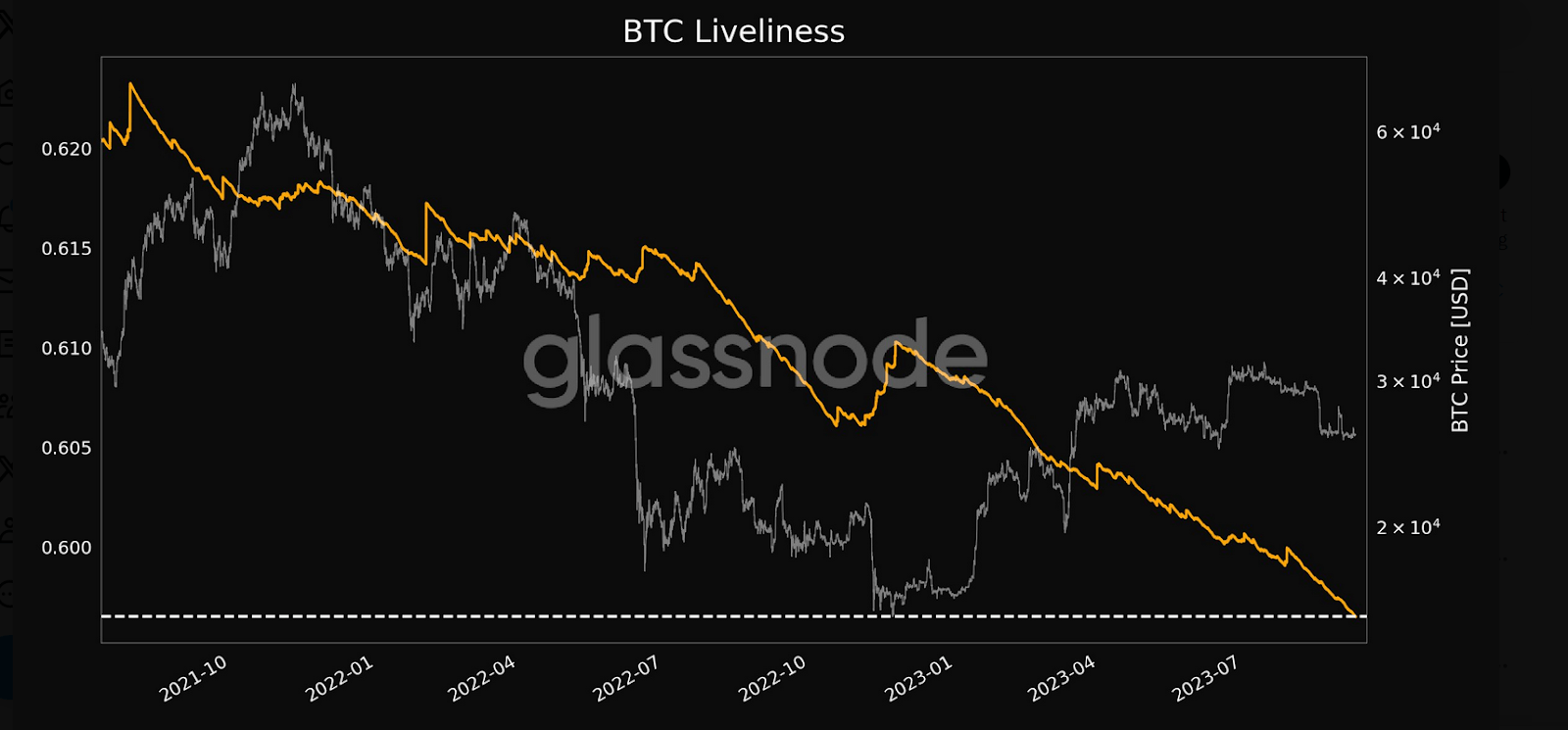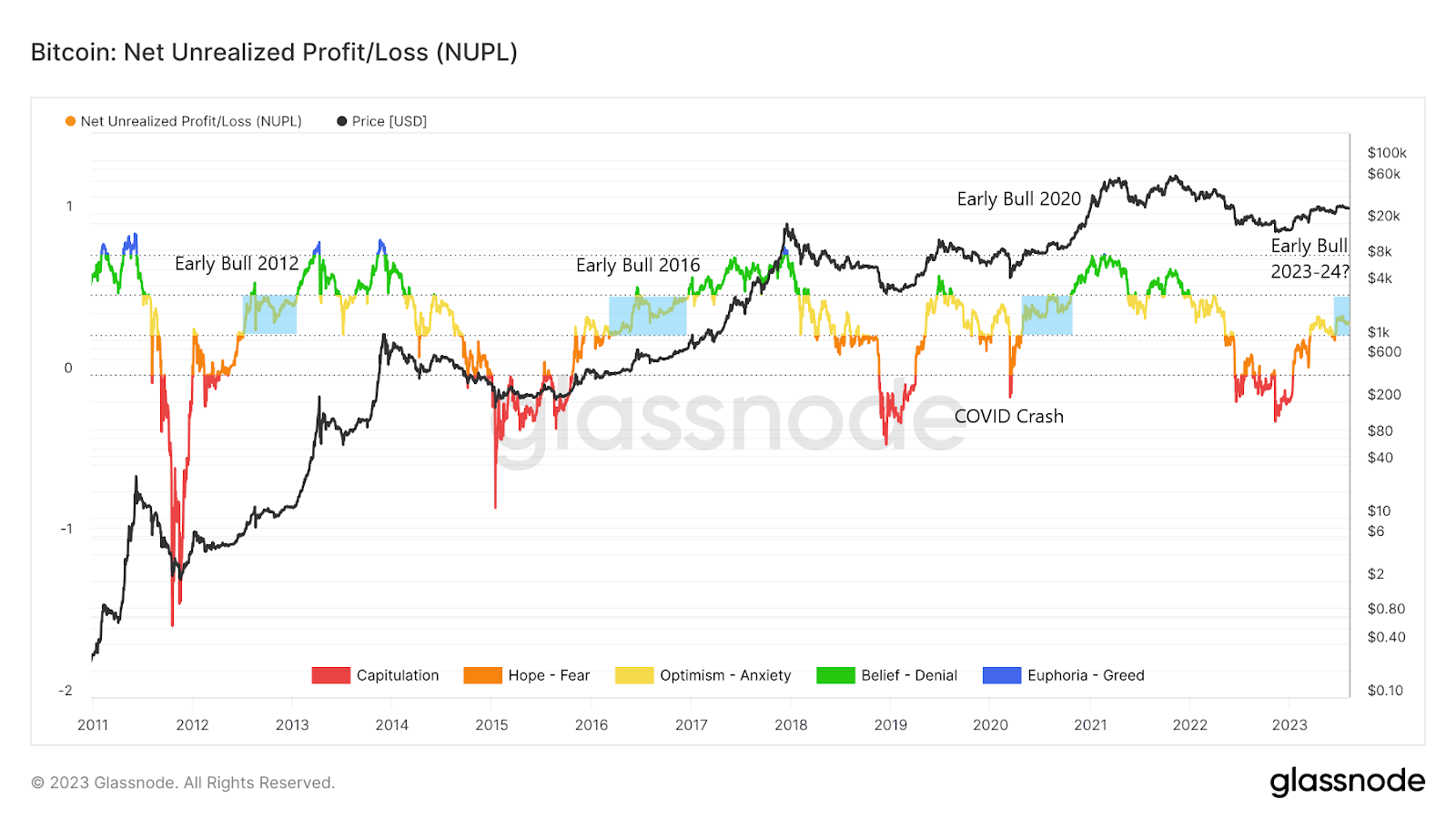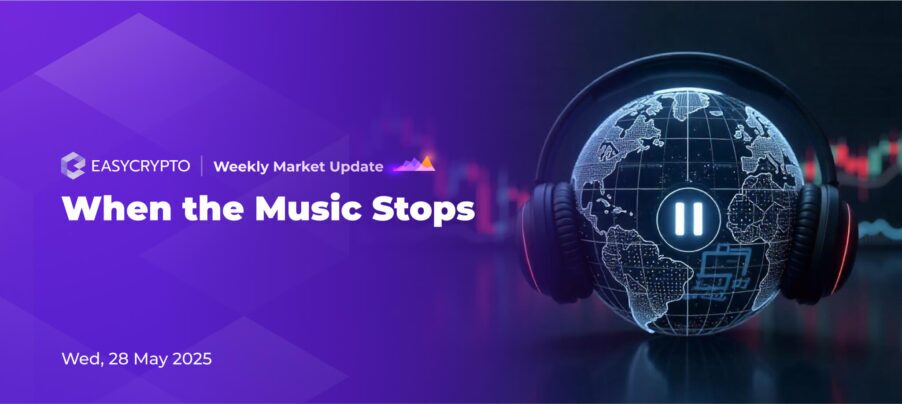When will Bitcoin reach a new all-time high?
Taking a look at two on-chain metrics, there has been a suggestion that, given that market conditions remain increasingly positive from this point on, Bitcoin's new all-time high could happen in six months.


When attempting to predict the future direction of the Bitcoin market, many people rely on traditional methods of analysis, such as technical and fundamental analysis. However, in recent months, these commonly used techniques have proven to be somewhat unreliable.
Technical analysts often engage in debates about the significance of patterns like the Golden Cross and the Death Cross appearing at different points in the Bitcoin price chart.
In reality, the Bitcoin market appears to be moving sideways, making it challenging for technical analysts to accurately predict its future trajectory.
What about the fundamental factors? There has been a lot of discussion about the likelihood and speed of approval for the first Bitcoin ETF by the US Securities and Exchange Commission.
Fundamental analysts have consistently argued that the introduction of a Bitcoin ETF would likely attract many well-off investors who are seeking a secure and convenient way to indirectly invest in Bitcoin, potentially driving up its price.
However, the world of cryptocurrency regulations is filled with rumours and lacks concrete facts. Therefore, when it comes to gaining insights into the Bitcoin market’s future, we may need to turn our attention to the Bitcoin blockchain itself.
Bitcoin HODLers are stronger in number
Bitcoin HODLers are on the rise, and this trend is becoming increasingly evident through a key metric known as Bitcoin Liveliness. According to the prominent on-chain analyst Glassnode, Bitcoin Liveliness has recently hit a two-year low, registering at 0.596 score.

This metric provides valuable insights into the behaviour of Bitcoin holders. It tells a story of their commitment to Bitcoin’s long-term investment potential.
While there were times that investors were hastily selling it for short-term gains, what we’re looking at in today’s current market condition is the opposite — an increasing number of investors are buying and holding Bitcoin, trusting in its future value.
The market in the past couple of months is characterised by a series of false bullish surges. Now, even in Bitcoin’s current sideways trend, this metric is shedding light on a growing trend in investors adopting a “buy and hold” strategy.
This approach signifies their confidence in Bitcoin’s ability to be less volatile in the near future, and suggests that we may have reached a price floor. Given that investors anticipate a potential increase in Bitcoin’s value, they are now choosing to retain their holdings.
So, how is Liveliness measured?
To calculate Liveliness, two critical factors are considered: the total number of days that all coins within the network have been held (collective age of all coins) and the total number of days that coins have been utilised in transactions, effectively resetting their age to zero.
The ratio of the days coins have been spent in transactions to the total age of all coins provides the Liveliness score.
Interpreting Liveliness is crucial in understanding the dynamics of a cryptocurrency network:
- A Liveliness score close to 1 indicates that coins are rapidly changing hands in frequent transactions.
- Conversely, a score near 0 suggests that coins are mostly stagnant, sitting idle in wallets.
- When Liveliness increases, it suggests that long-term holders are starting to use their coins for transactions, indicating a more vibrant and dynamic cryptocurrency ecosystem.
- Conversely, a decrease in Liveliness indicates that more people are holding onto their coins as investments rather than actively using them for transactions, signalling a less active cryptocurrency ecosystem.
In summary, the currently decreasing Liveliness score, as calculated by Glassnode, reflects the changing behaviour of Bitcoin investors, from feeling hesitant to hold Bitcoin as an investment, to gaining confidence that the price may have reached some level of stability.
Net Unrealized Profit and Loss, another supporting metric
Net Unrealized Profit and Loss (NUPL) is a financial metric that offers insight into the profit or loss potential of investors’ Bitcoin holdings, even if they haven’t actually sold them. As it is a rather complex metric, we can explore it further with an analogy.
Imagine you own a diverse collection of valuable trading cards, each acquired at various prices over time. NUPL is akin to determining the total profit or loss you would incur if you were to sell all your cards at their current market values.
To determine your overall NUPL for your entire collection of trading cards, you aggregate all the profits and losses associated with each card. If the total profit is positive, it signifies that you would generate a profit by selling all your cards at their current market values. Conversely, a negative NUPL suggests that you would suffer losses under such circumstances.
In the realm of Bitcoin, NUPL serves as a means to gauge how much profit or loss investors would experience if they were to sell their investments at prevailing market prices compared to their original purchase prices.
It offers valuable insights into the sentiment of market participants and their comfort level with their existing holdings. When NUPL is positive, it indicates that a majority of Bitcoin holders are in profit, potentially reducing the inclination to sell. A negative NUPL implies that many are incurring losses, potentially exerting selling pressure on the market, as investors become too uncomfortable to incur further losses.
Bitcoin’s NUPL suggests all-time high is 6 months away
Crypto market analyst Jakub Dziadkowiec who writes in the crypto news site Beincrypto used Glassnodes’ on-chain NUPL data to have a try at predicting when Bitcoin might reach an all time high. His conclusion arrives at the timeframe of six months from now, give or take.

The NUPL indicator provided by Glassnode is enticingly coloured to show periods of time when Bitcoin investors feel one of eight emotions — hope, optimism, belief, euphoria, greed, denial, anxiety, and fear. The emotions are associated with the degree of the NUPL, and that is also superimposed on the Bitcoin historical price chart to help you see the patterns.
Currently, Bitcoin’s NUPL falls within the yellow range, specifically between 0.25 and 0.50, suggesting a prevailing sense of optimism among investors. Historical data suggests that this range typically corresponds to the Bitcoin accumulation phase that characterises a possibly early stage of a bull market.
The conclusion that Bitcoin might reach all time high in six months are based on three crucial assumptions:
- The first assumption is that Bitcoin investors continue to believe in Bitcoin. In terms of the chart, the NUPL would move up towards the green zone. Of course, if the market experiences another significant decline, the NUPL could potentially drop back into the orange and even the red zone. This has happened before during the March 2020 market crash.
- The second assumption is that Bitcoin’s ongoing accumulation phase is expected to be similar to previous instances, lasting approximately 7 months or 32 weeks. This estimation is derived from the average duration of Bitcoin accumulation periods within the yellow NUPL range (which have spanned 30, 41, and 25 weeks in previous cycles, respectively).
- The third assumption is that Bitcoin’s all-time high would reach its peak around 12 months or 51 weeks after entering the late phase of a bull market. This aligns with the average duration observed in past cycles.
Further changes to the ever-complicated dynamics of price and investor sentiment could push the timeframe further.
At the current trend, however, the accumulation phase is expected to last around 7 weeks. Subtracting this timeframe from the averaged accumulation duration of 32 weeks yields a period of roughly 6 months.
The takeaways
While it’s useful to look into on-chain metrics such as the Bitcoin Blockchain Liveliness and the Net Unrealised Profit/Loss, in reality, the Bitcoin market is complicated, and many factors come into play. It’s also important to understand that metrics don’t cause crypto prices to move — it’s normally the other way around.
Perhaps the biggest driver of prices in any kind of risk assets is the macroeconomic cycle. This is something that Bitcoin investors must pay attention to first and foremost.
Indicators, whether they are for on-chain or pricing analysis, will follow and provide the necessary signals for short to medium traders to base their decisions upon.
Remember to always be critical and do your own research before making any important financial decisions.
Further reading: Explore our hub to learn all things crypto.
Share to
Stay curious and informed
Your info will be handled according to our Privacy Policy.
Make sure to follow our Twitter, Instagram, and YouTube channel to stay up-to-date with Easy Crypto!
Also, don’t forget to subscribe to our monthly newsletter to have the latest crypto insights, news, and updates delivered to our inbox.
Disclaimer: Information is current as at the date of publication. This is general information only and is not intended to be advice. Crypto is volatile, carries risk and the value can go up and down. Past performance is not an indicator of future returns. Please do your own research.
Last updated September 12, 2023





